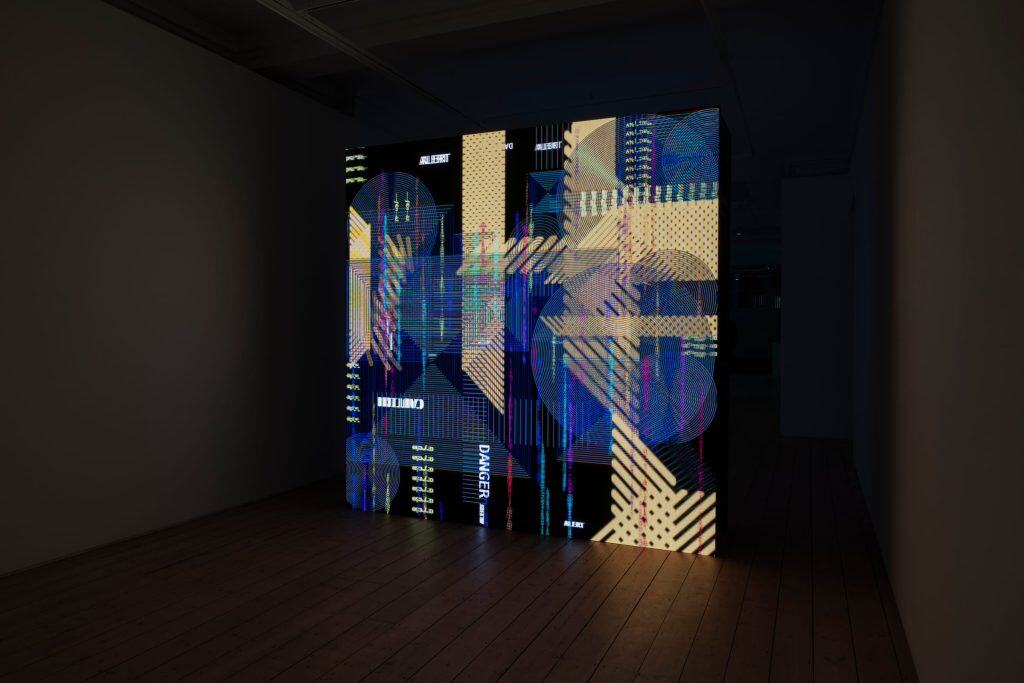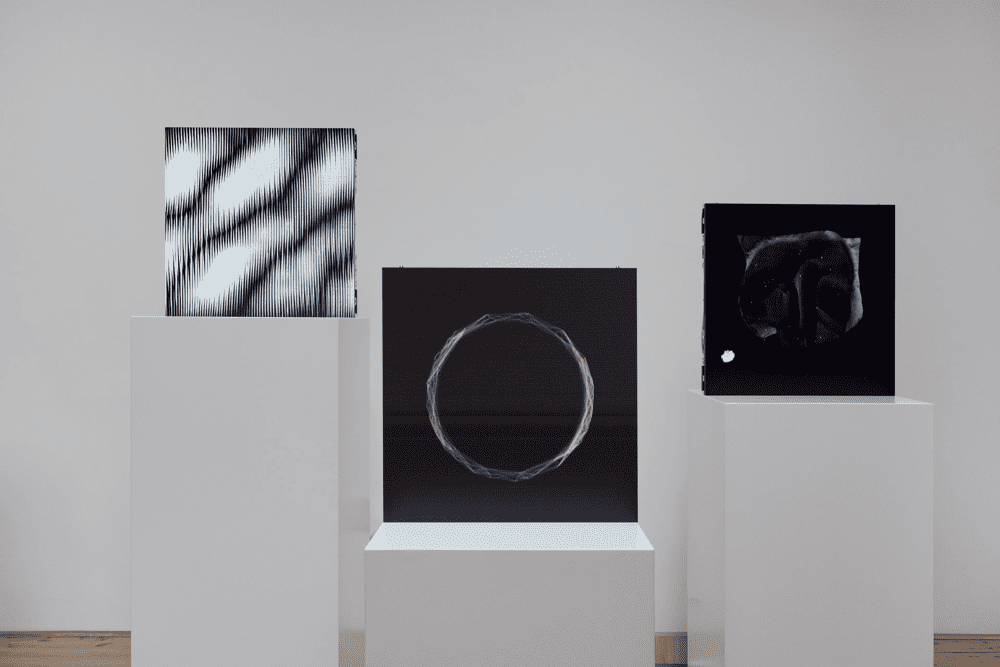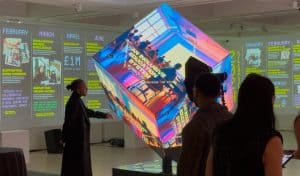Dynamo LED Displays Powers Botto’s “Algorithmic Evolution” NFT Art Exhibition
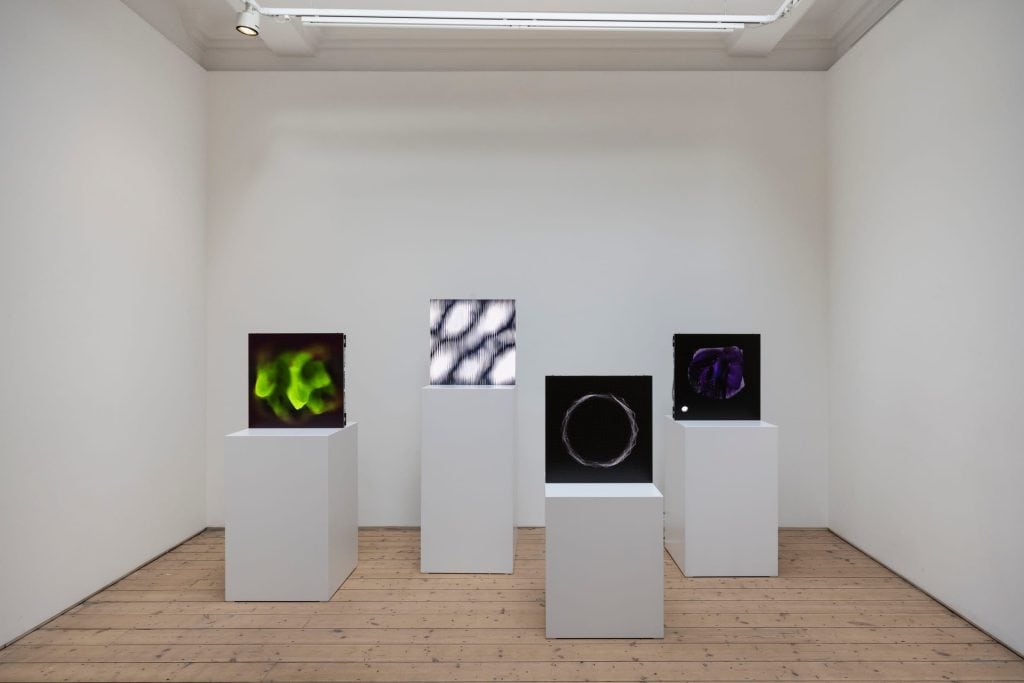
Introduction to Dynamo LED Displays
Dynamo LED Displays is a leading provider of high-quality LED screen solutions with a global footprint. Based in both the UK and Dubai, the company has over 15 years of experience and has emerged as a premier supplier of purpose-built LED displays for a wide range of applications.
Dynamo is renowned for merging art and technology, constantly evolving its products to deliver visually stunning, innovative installations. The company has a strong track record of innovation in digital art displays, having worked with many leading artists (including Turner Prize-winner Mark Leckey) to create impressive LED art installations
This commitment to pushing boundaries and collaborating with artists made Dynamo the perfect partner for the cutting-edge Botto NFT art exhibition, Algorithmic Evolution.
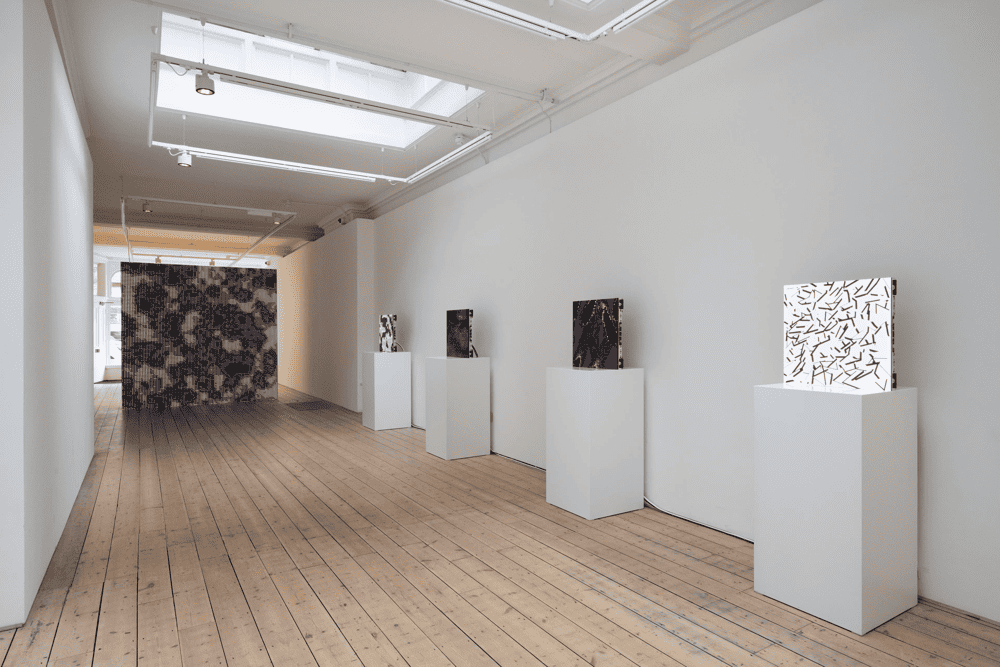
Overview of the Botto NFT Art Exhibition:
Algorithmic Evolution
Botto is a decentralised autonomous artist – an AI-driven art creator conceptualised by artist Mario Klingemann and governed by a community DAO. The Algorithmic Evolution exhibition marks a defining moment in Botto’s trajectory, unveiling Botto’s first collection of algorithms created via p5.js (a JavaScript creative coding library) after an intensive period of self-directed exploration, community participation, and iterative refinement. In early 2024, Botto began a 19-week experiment to expand its artistic practice beyond text-to-image generation into code-based generative art. Through this process, thousands of dynamic visual algorithms were evolved and refined with the help of community feedback and Botto’s own autonomous critique. The culmination of this study was 22 final algorithms—an Algorithmic Evolution collection distilled from over 6,500 generated pieces.
The Algorithmic Evolution NFT art exhibition at a London gallery, featuring Dynamo LED screens showcasing Botto’s AI-generated artworks. Over 22 algorithmic art pieces were displayed on high-resolution LED panels, creating an immersive digital art experience.
Curated and presented by Verse’s SOLOS initiative, the exhibition ran from 19–22 February 2025 at 34 Mortimer St, London, and drew significant attention in the digital art community. Not only does Algorithmic Evolution showcase AI-generated art in a gallery setting, it also brings these works into the NFT realm by committing all 22 algorithms to the blockchain (each algorithm exists as an NFT), effectively blurring the lines between generative art and collectible digital assets.
This innovative blend of AI art and NFTs highlights the evolving relationship between creators, audiences, and ownership in the digital art space. The opening night alone saw over 400 attendees, underscoring the exhibition’s significance; a panel discussion featured notable figures in AI and art (including Botto’s team and curators from the V&A and The Art Newspaper), further cementing the event as a milestone in the art-tech world.
Technical Details of the LED Screen Installation
To present Botto’s digital artworks with maximum fidelity, the exhibition utilised a sophisticated LED screen setup provided by Dynamo LED Displays. The display configuration was meticulously designed to showcase both the intricate details and the dynamic motion of Botto’s generative pieces. It comprised a combination of numerous small, high-density LED panels for individual artworks and large-format LED walls for immersive visuals. The installation included:
- 22× DRE Series 1.29 mm LED screens – Each screen is a 496 mm × 496 mm panel with a resolution of 384 × 384 pixels. These ultra-fine-pitch displays provided incredibly sharp and detailed imagery for each of Botto’s 22 algorithmic art pieces. The compact DRE series panels feature seamless module alignment, ensuring that even when viewed up close, the pixels are virtually indistinguishable and the art appears smooth and continuous.
- 2× DEX Series 2.06 mm back-to-back LED screens – Two large double-sided screens, each measuring 2.48 m × 2.48 m with a 1200 × 1200 pixel resolution, served as the centerpiece of the exhibition. Placed back-to-back, these expansive LED walls displayed Botto’s visuals in a free-standing format, viewable from multiple angles. The DEX series panels offer a slightly larger pixel pitch (2.06 mm) ideal for mid-range viewing, and their back-to-back configuration allowed visitors to experience evolving artworks from either side, effectively doubling the visual impact.
A close-up of Dynamo’s ultra-fine-pitch LED screens displaying three of Botto’s generative artworks. The 1.29mm pixel pitch DRE series panels deliver stunning detail and color, bringing the algorithmic art to life.
Such high-spec LED displays were chosen for their ability to do justice to Botto’s vibrant algorithmic art. They offer multiple benefits for digital art exhibitions:
- Ultra-High Resolution: The fine pixel pitch of the screens ensured razor-sharp rendering of the digital artwork. Even subtle generative details and tiny motions were displayed clearly, allowing viewers to appreciate the full complexity of Botto’s creations at close range. High resolution, combined with high brightness and contrast, means the images remained crisp and impactful even under gallery lighting.
- Seamless Integration: The modular design of Dynamo’s LED panels enabled a bezel-free setup, creating the impression of digital canvases floating in the gallery space. The screens were expertly mounted and calibrated for perfect alignment and colour uniformity, resulting in a cohesive visual experience. This seamless integration was crucial in immersing visitors in Botto’s art without technological distractions.
- High Refresh Rate & Colour Accuracy: Dynamo’s LED screens feature high refresh rates (3840hz) and exceptional colour reproduction, which meant Botto’s evolving graphics were presented with smooth motion and true-to-life colours. Fast-moving generative animations were rendered flicker-free, and the wide colour gamut and calibration ensured that every hue and gradient appeared as the artist (and algorithm) intended. The screens’ high contrast ratio and colour accuracy provided “breathtaking” results that left viewers captivated.
In terms of setup, Dynamo’s team handled the complete installation process—from structural mounting of the screens to fine-tuning the display settings for optimal viewing. Each of the 22 smaller DRE screens was placed on individual plinths at eye-level, giving each algorithmic artwork its own dedicated display akin to a digital canvas. The two large DEX 2.06 mm screens were installed back-to-back in the center of the gallery, secured on a sturdy frame to allow 360° visibility. Careful calibration was performed so that brightness and colour settings were consistent across all screens, ensuring a uniform look as visitors moved through the space. The end result was an impressive, immersive setup where the technology quietly empowered the art – the LED screens delivered Botto’s works with stunning clarity and motion, effectively vanishing behind the content and letting the art speak for itself.
Past Collaborations with Verse
The partnership between Dynamo LED Displays and Verse is not new; it builds on a history of successful collaborations in the digital art scene. Prior to Algorithmic Evolution, Dynamo played a key role in Verse’s exhibition of NFT art by famed digital artist Zach Lieberman. In that exhibition at Verse’s London gallery, art lovers were treated to Lieberman’s interactive digital artworks displayed on two impressive LED screens supplied by Dynamo. Dynamo was called in at the last minute (just the night before the opening) to equip the gallery with these 2m × 2m LED walls, and they rose to the challenge brilliantly. The screens, boasting the latest LED technology and high-contrast, high-resolution imagery, became a central highlight of the show. Visitors were mesmerised by the vibrant visuals, and the consensus was that the LED displays “were the star of the show,” complementing Lieberman’s NFTs perfectly and bringing his digital art to life in the physical space.
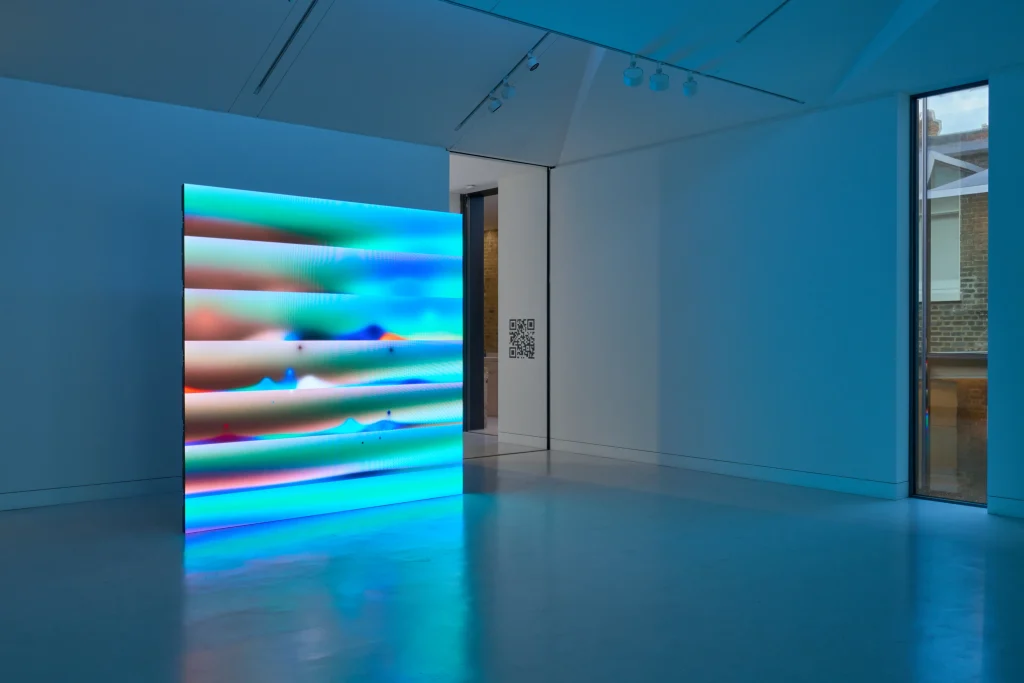
This previous success with Verse demonstrated Dynamo’s ability to seamlessly integrate LED technology into an art exhibition on short notice, without compromising on quality or experience. It built trust and rapport between Dynamo and the Verse team. Thus, when the Botto exhibition was being planned, Verse once again enlisted Dynamo’s expertise to deliver the high-end LED screens required. Dynamo’s consistent track record of reliability, technical excellence, and understanding of an artist’s vision (honed through years of working with digital artists and galleries) made them an obvious collaborator for yet another groundbreaking NFT art show. The ongoing relationship with Verse highlights Dynamo LED Displays’ role as a go-to innovator for digital art exhibitions in London and beyond.
Enhancing the Art Experience Through LED Technology
The Botto exhibition is a prime example of how high-quality LED display technology can elevate digital and NFT art installations to new heights. By using state-of-the-art LED screens as the medium, the exhibition bridged the gap between the digital and physical realms. Visitors were not just looking at art on screens; they were experiencing algorithmic art unfolding in real time with a vividness and scale that traditional prints or monitors could never achieve. The large LED walls and numerous panels essentially turned the gallery into an immersive canvas for Botto’s creativity, proving that LED technology can transform how we engage with digital art.
LED displays offer unique advantages for showcasing digital art. Their high brightness and contrast allow digital artworks to “pop,” even in well-lit gallery environments, ensuring perfect visibility and colour vibrancy. Their scalability means artists can go as big (or as small) as needed – from individual panel displays to massive video walls – without losing image fidelity. In the case of Algorithmic Evolution, the ultra-fine pixel pitch screens allowed intricate generative patterns to be seen in great detail, while the larger screens provided an enveloping panorama of Botto’s visuals. The result is a deeply engaging experience: as many visitors noted, the dynamic LED displays breathed life into each piece, allowing viewers to fully immerse themselves in the art. Unlike static prints, the LED-based artworks were dynamic and ever-changing, and the technology faithfully rendered these changes with zero lag or blurring, keeping the audience entranced by the evolving imagery.
Interactivity and engagement are also enhanced through LED technology. While Botto’s algorithms themselves were the performers, one can imagine how such LED setups could integrate interactive elements – for example, responsive sensors or live data inputs – to make digital art reactive to viewers. Dynamo LED’s solutions support a range of integrations (from motion sensors to interactive software), opening up possibilities for artists to create participatory NFT art experiences. This means that the future of digital art exhibitions could involve even more audience interaction, with LED screens not just displaying content but actively responding to viewers in real time, creating a two-way dialogue in art installations.
The success of Algorithmic Evolution also hints at a broader trend: museums and galleries are increasingly adopting LED displays to showcase digital art and NFTs. High-definition LED walls are becoming the modern canvases for artists who work in code, video, and interactive graphics. Thanks to their flexibility and visual impact, these displays can transform any space into an immersive art environment. In fact, some of the world’s most talented artists today are using large-format LED technology to create innovative, thought-provoking art on digital canvases, and many are seeking out cutting-edge, custom LED solutions to realise their visions. As the art world evolves, we can expect LED displays to play an even greater role – from NFT galleries and crypto-art shows, to experiential art pop-ups and beyond. Dynamo LED Displays stands at the forefront of this movement, continually advancing LED screen capabilities (such as even finer pixel pitches, curved and flexible panels, transparent LED displays and higher dynamic range visuals) to expand what’s possible in digital art exhibitions.
Client Feedback & Industry Recognition
The collaboration between Dynamo LED Displays and the Botto exhibition has been met with enthusiastic praise. Holly Wrench of Verse (the curator of the show) lauded Dynamo’s contribution, saying:
“Thank you for our wonderful exhibition, we’re getting a ton of people enquiring about the screens!”
This feedback highlights how crucial the LED screens were to the exhibition’s impact – so much so that attendees and other interested parties took notice of the displays themselves and wanted to learn more about them. Such a response is a testament to the quality and effectiveness of Dynamo’s work. It’s not just the art community that took note; the LED display industry also recognises the project as a showcase of what advanced LED technology can achieve in a fine-art context. An exhibition that draws hundreds of visitors and sparks conversation about the screens as much as the art is clearly setting a benchmark for digital art presentation.
Visitors to Algorithmic Evolution frequently commented on the immersive atmosphere created by the LED visuals, and many social media posts about the event mention how the art “came alive” thanks to the vibrant screen display. This positive reception reinforces the idea that pairing digital art with the right display technology significantly enhances audience engagement. The success of the Botto exhibition has positioned Dynamo LED Displays as a leader in this niche – demonstrating to galleries and artists alike that museum-quality, high-resolution LED installations can be the key to unlocking new levels of viewer fascination in digital art shows. The project has not only delighted the client (Verse) and the viewers, but also solidified Dynamo’s reputation for excellence and innovation in the art exhibition arena.
Conclusion & Call to Action
Dynamo LED Displays played an integral role in bringing Botto’s Algorithmic Evolution NFT art exhibition to life, literally illuminating the intersection of art and technology. By providing the ultra-high-resolution LED screens and the technical expertise to deploy them, Dynamo enabled a groundbreaking showcase of AI-generated art in a physical gallery, setting a new standard for how digital art can be experienced in person. The exhibition demonstrated that with the right technology partner, even the most avant-garde creative ideas (like a DAO-driven AI artist) can be translated into compelling real-world experiences. Dynamo LED Displays is proud to have been the visual backbone of this exhibition, and the success of the event underscores the company’s mission to support artists and innovators with the best display tools available.
For artists, galleries, and NFT creators looking to push the envelope of digital art, Dynamo LED Displays extends an invitation to collaborate. Whether you’re planning the next big NFT gallery launch, an immersive art installation, or any project that could benefit from stunning visual displays, Dynamo’s team is eager to help make it a reality. The company’s expertise in delivering custom LED solutions ensures that creative visionaries have a capable partner to illuminate their work. As seen with Botto’s exhibition and past projects, Dynamo’s LED technology can elevate art into an immersive experience that captivates audiences.
Ready to transform your digital art exhibition with state-of-the-art LED screens? Visit the Dynamo LED Displays contact page to learn more about our high-quality LED solutions, explore our portfolio of past installations, and get in touch with our team. Let’s create the next unforgettable digital art experience together.

